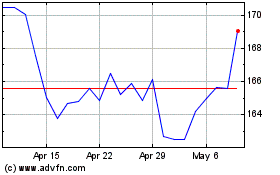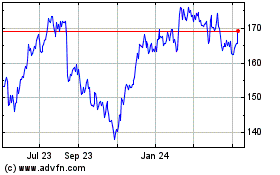By Jason Zweig
The best-performing stock of the past 30 years isn't Warren
Buffett's Berkshire Hathaway Inc., Microsoft Corp. or Apple Inc.
It's little-known Jack Henry & Associates Inc., which provides
technology to banks and other financial firms from its headquarters
in Monett, Mo. ( population 8,873).
Jack Henry's story is common among the " superstocks" with the
highest long-run returns. Once-tiny companies, often neglected by
professional investors for years, end up earning higher returns
than stocks that were far bigger and better-known.
Surprisingly, small investors may have a big edge over Wall
Street's giants in capturing these gains. That's because, to earn
such superior long-term results, you have to withstand
bone-cracking short-term downdrafts along the way -- something most
fund managers can't do.
That insight emerges from an analysis by Wilshire Associates for
David Salem, co-chairman of New Providence Asset Management L.P.,
an investment firm in New York.
If you'd invested $1,000 in Jack Henry stock at the closing
price on Sept. 30, 1989, you'd have had $2,763,000 as of this Sept.
30, according to the Wilshire data. The same $1,000 invested in
Berkshire Hathaway would have grown to $36,000; in the S&P 500,
$16,000. Those figures include reinvested dividends.
Earning that spectacular gain, however, would have taken almost
superhuman determination: From June 2001 through October 2002, Jack
Henry's shares fell 67%. Between October 1996 and August 1999, the
stock underperformed the S&P 500 by a cumulative 72 percentage
points.
The numbers are consistent: Among the top 10 stocks over the
past three decades, four -- Fair Isaac Corp., Kansas City Southern,
Best Buy Co. and Monster Beverage Corp. -- suffered interim
declines of at least 75%, according to Wilshire. To end up earning
hundreds of times your original investment, you would have had to
lose at least three-quarters of your money along the way.
Monster's stock dropped 92% from March 1990 through December
1995; the shares cumulatively underperformed the S&P 500 by 534
percentage points between late 1990 and early 2000, according to
Wilshire. Yet $1,000 invested in Monster's stock three decades ago
grew to $506,000 by this past Sept. 30.
Surely only a professional investor can withstand that kind of
pain? Au contraire, says Mr. Salem: "It's potentially career-ending
for a manager to hold such big interim losers. I wonder if any
manager has ever been able to stay the entire course with stocks
like these."
A dirty secret of the investment business is that fund managers
don't buy and hold -- not because they don't want to, but because
they can't.
That isn't just because clients would fire them for holding on
to losers.
The more successful a little company is, the faster it becomes
midsize and then large. Consider Amazon.com Inc. It went public in
1997 with a market value of about $300 million, qualifying it as a
small company. Less than three years later, the stock had a market
value of nearly $13 billion.
Small-company mutual funds that owned Amazon when it was tiny
had to sell it once its market value grew into the billions.
Otherwise it would have dominated their portfolios. Investors in
those funds missed out on nearly all of Amazon's stratospheric
growth.
Small stocks earn their highest returns not when they are small
but rather as they migrate to large, according to research by
finance professors Eugene Fama and Kenneth French.
That description fits Jack Henry to a T.
Founded in 1976, the company first sold shares to the public in
November 1985. As of 1996, insiders still owned 41% of the stock;
not until 2006 did any institutional investor show up owning 5% or
more of the shares. Only in November 2018 did Jack Henry finally
grow large enough to join the S&P 500 index, where it currently
ranks 402nd by size.
The stock is no longer cheap -- it trades at a steep 41 times
the past 12 months' earnings and eight times book value, according
to FactSet -- but Jack Henry doesn't ride many market fads. "Most
of our growth has been truly organic," coming from business
expansion rather than acquisitions, says finance chief Kevin
Williams.
Unlike a lot of larger companies, Jack Henry hasn't borrowed
money to finance massive buybacks of its own stock; it has no
long-term debt. On the back of the company's business cards is the
founders' original motto: "Do the Right Thing, Do Whatever It
Takes, Have Fun."
Today, 94% of Jack Henry's stock is held by institutions, but
it's unlikely any single fund manager has held the shares
continuously for the whole wild ride.
Who could? For all the talk about how individual investors have
faded as a market force, results like Jack Henry's are a reminder
that no other constituency is in a better position to buy and
hold...and hold...and hold.
No one can fire you for hanging onto a stock that loses 75% or
more; you are free to seek value in the most obscure companies or
to find hope in the darkest hour.
In 1974, the financial analyst Benjamin Graham said: "I am
convinced that an individual investor with sound principles, and
soundly advised, can do distinctly better over the long pull than a
large institution."
He was right then, and his words may be even truer today.
Write to Jason Zweig at intelligentinvestor@wsj.com
(END) Dow Jones Newswires
December 13, 2019 11:14 ET (16:14 GMT)
Copyright (c) 2019 Dow Jones & Company, Inc.
Jack Henry and Associates (NASDAQ:JKHY)
Historical Stock Chart
From Mar 2024 to Apr 2024

Jack Henry and Associates (NASDAQ:JKHY)
Historical Stock Chart
From Apr 2023 to Apr 2024
